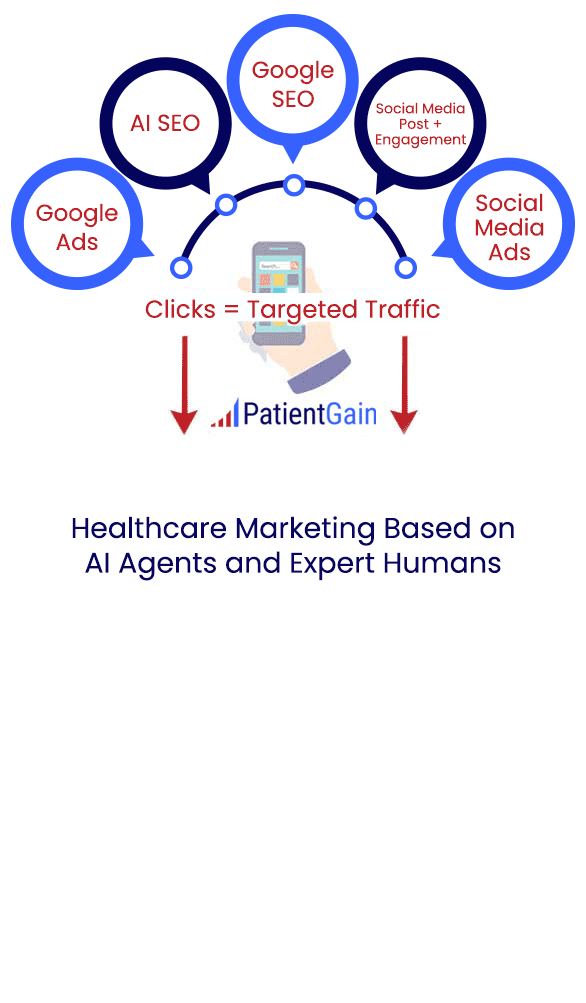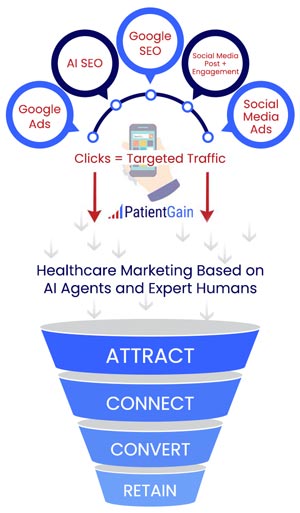Medical SEO ROI Examples
Key Question: Does medical SEO work and produce any ROI ? (Return On Investment)
Answer: YES!!! However it is slow, very complex and requires constant work. In other words, it is not easy.
The ROI for healthcare SEO is significant, with benchmarks often ranging from 5x to 12x(or a 500% to 1200% return) due to the high patient lifetime value. This is based on the formula: ROI = (Gain from Investment – Cost of Investment) / Cost of Investment × 100. Achieving positive returns can take 6–12 months, as SEO focuses on building long-term, consistent, and high-quality patient leads rather than immediate, one-time conversions.
Example of a good SEO of an Asthma clinic in Georgia.
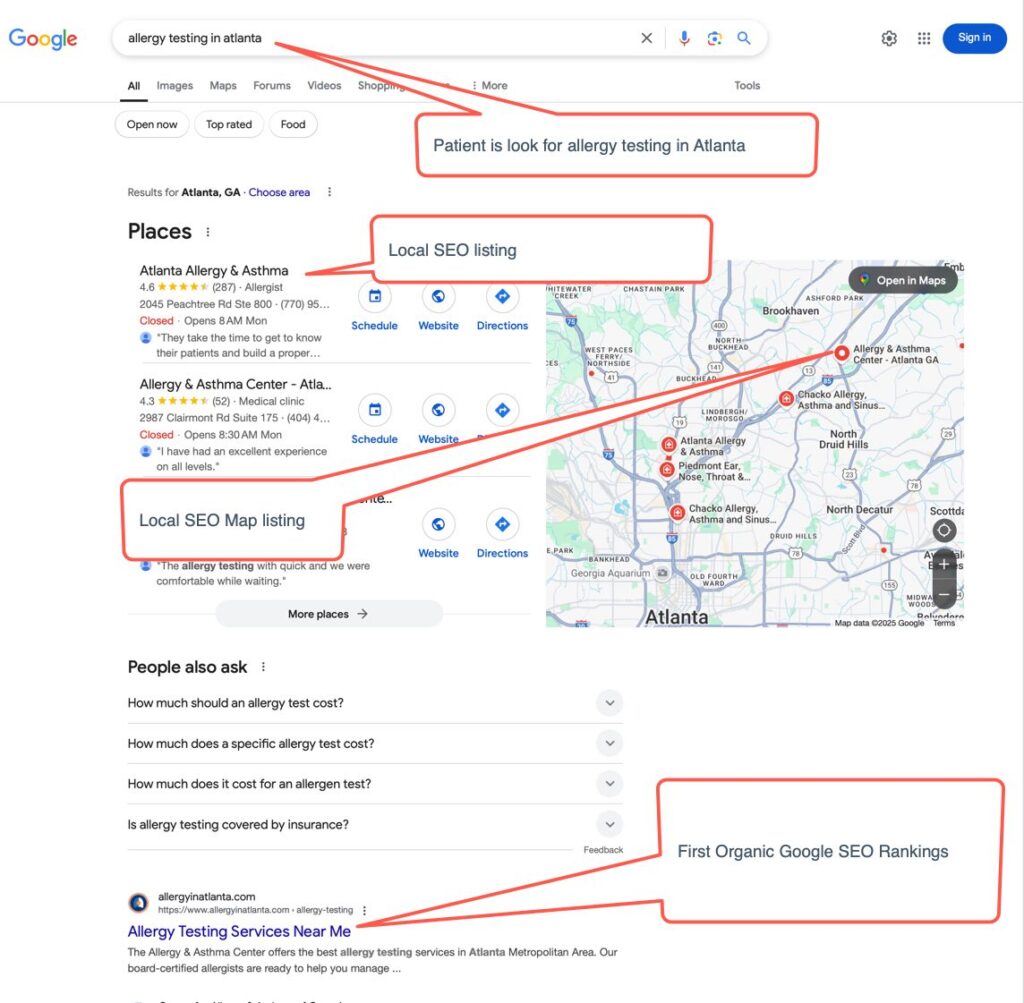
As an example: If you go to Google search and look for Medical SEO or Medical SEO companies – You should see similar results like below – This means that medical providers are who are searching for “Medical SEO companies” or “Medical SEO” are likely to find PatientGain.com in the top of the results ( Not in the sponsored ads – but in the free organic search)
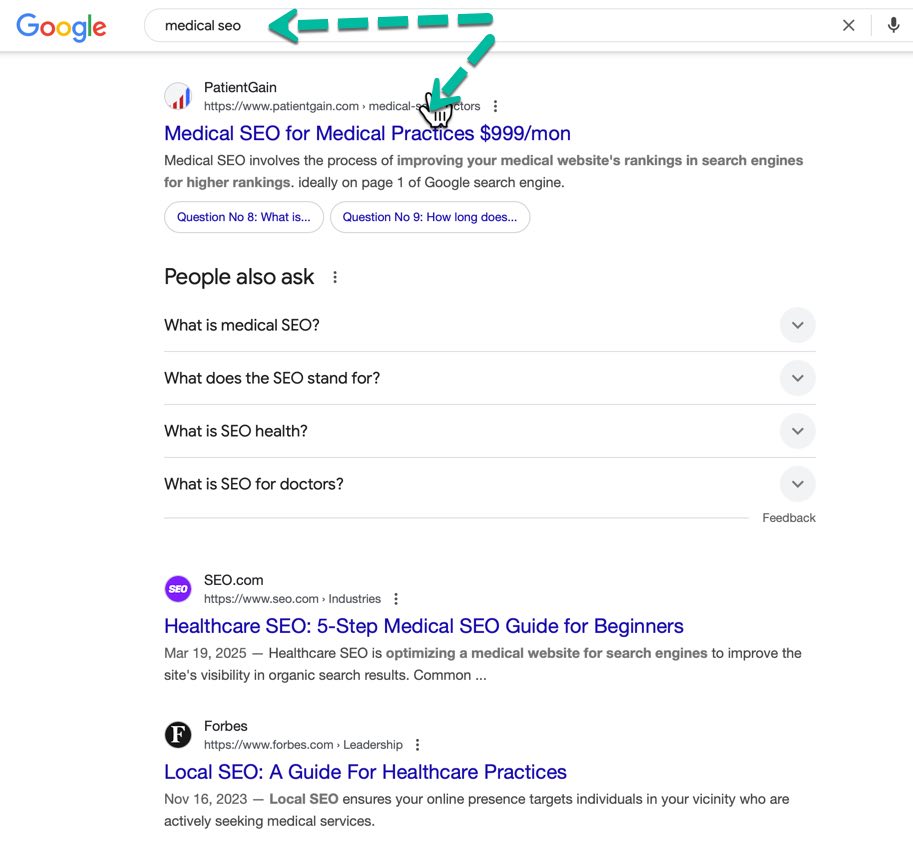
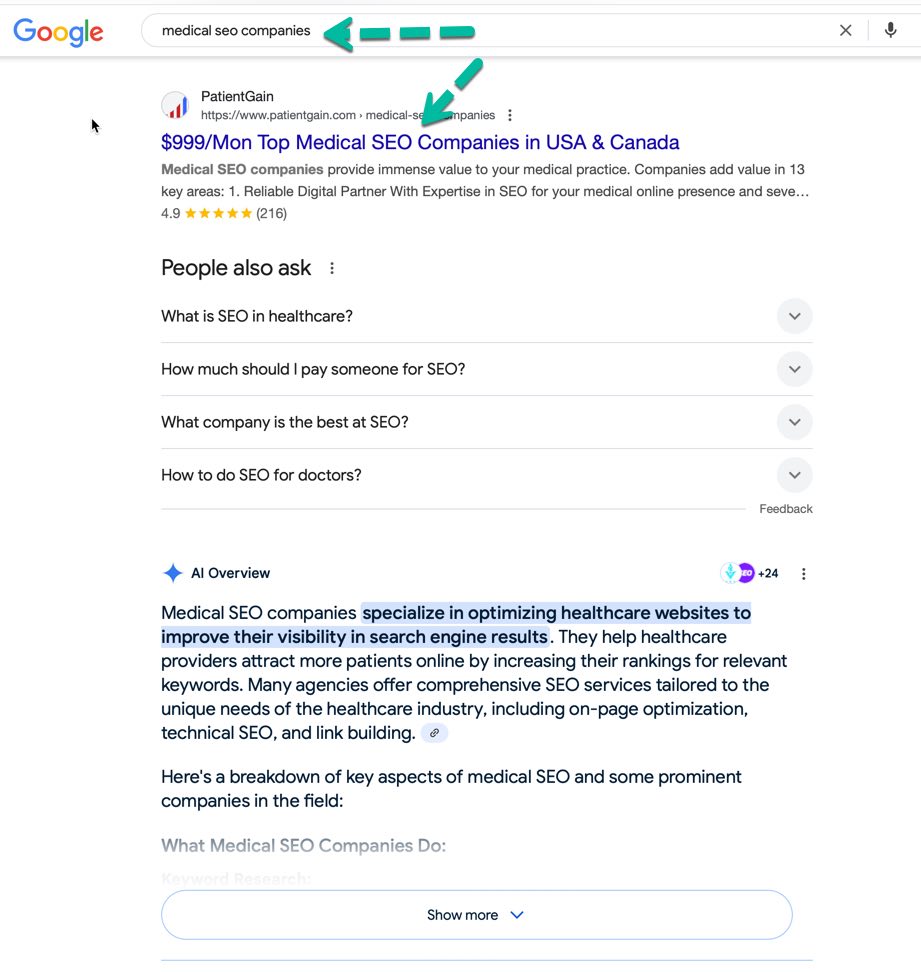
Medical SEO can have a significant impact on various types of medical practices:
1. General Practice and Family Medicine
- Example: A family medicine clinic in Austin, TX focuses on providing preventive care, check-ups, and treatment for common health issues.
- How SEO Works: By optimizing for search terms like “family doctor Austin, TX” or “best pediatrician in Austin,” the clinic can appear at the top of search results for individuals actively looking for general healthcare providers. As a result, they can gain new patients who are in their geographical area and need routine healthcare.
- ROI: With SEO and local SEO, the clinic could see an increase in organic traffic to its website, especially from people who are new to the area or seeking new healthcare providers. Over time, this traffic translates into more appointments and patient retention, providing long-term value.
2. Dentistry
- Example: A cosmetic dental practice specializing in teeth whitening, dental implants, and veneers in Los Angeles, CA.
- How SEO Works: By targeting keywords like “cosmetic dentist Los Angeles” or “best teeth whitening in LA,” the practice can rank higher on Google when people search for dental cosmetic services in that area. SEO efforts may also include content marketing, such as blog posts on “how dental implants work” or “benefits of professional teeth whitening.”
- ROI: This dental practice can expect a significant ROI as potential patients actively searching for cosmetic dental procedures are led directly to their website. SEO brings in highly qualified traffic who are likely to convert into paying customers, increasing the clinic’s bottom line.
3. Chiropractic Care
- Example: A chiropractic clinic that focuses on back pain, spinal decompression, and neck pain treatment in Chicago, IL.
- How SEO Works: The clinic optimizes for keywords like “chiropractor for back pain Chicago” or “spinal decompression therapy Chicago.” In addition, creating educational content on how chiropractic care alleviates neck pain, or the benefits of spinal adjustments, can help in ranking for relevant searches.
- ROI: People suffering from chronic pain or discomfort often search for treatments nearby. When this chiropractic practice ranks well for such searches, they attract new patients seeking long-term solutions. As a result, SEO leads to increased appointments, improved patient outcomes, and retention due to the high satisfaction of people who find relief from pain.
4. Cosmetic Surgery
- Example: A cosmetic plastic surgery clinic offering services like breast augmentation, rhinoplasty, and tummy tucks in Miami, FL.
- How SEO Works: The clinic can optimize its website for competitive keywords like “best tummy tuck surgeon in Miami” or “breast augmentation Miami, FL.” The content strategy could include before-and-after galleries, patient testimonials, and detailed descriptions of each procedure.
- ROI: Cosmetic surgery is a high-investment service, and ranking high for specific cosmetic procedures can significantly increase the clinic’s visibility and patient leads. The clinic would see a boost in consultations and, ultimately, surgeries booked through SEO, leading to a high ROI.
5. Weight Loss Clinics
- Example: A weight loss clinic offering services such as medical weight loss programs, nutrition counseling, and weight loss injections in Dallas, TX.
- How SEO Works: Targeting specific keywords like “medical weight loss Dallas” or “GLP-1 injections for weight loss in Dallas” ensures that people looking for serious, medically supervised weight loss programs can find the clinic’s website. Blogging about topics like “how GLP-1 helps with weight loss” or “benefits of medically supervised weight loss programs” can attract more organic traffic.
- ROI: Patients searching for effective, medically-assisted weight loss solutions are more likely to convert. With SEO driving targeted traffic, the clinic can generate more leads and consultations for its weight loss services, translating into increased revenue.
6. Urgent Care Clinics
- Example: An urgent care clinic in Miami, FL providing services like flu shots, X-rays, and treatment for minor injuries and illnesses.
- How SEO Works: The clinic can rank for keywords such as “urgent care Miami” or “walk-in clinic near me” for local searches. It can also rank for specific queries like “flu shots Miami” or “X-ray services near me.” Optimizing the clinic’s Google My Business profile and ensuring it shows up in the local pack can help attract immediate walk-ins.
- ROI: Since urgent care centers typically deal with immediate, unscheduled visits, ranking well for local searches boosts visibility and provides potential patients with the option of walking in for treatment. This increases both the clinic’s foot traffic and overall patient volume.
7. Pediatric Care
- Example: A pediatric clinic in Phoenix, AZ providing routine check-ups, vaccinations, and treatment for common childhood illnesses.
- How SEO Works: Optimizing for search queries like “pediatrician Phoenix, AZ” or “best kids doctor in Phoenix” ensures that parents looking for trusted pediatric services can find the clinic easily. SEO efforts may also include educating parents through blog posts on “common childhood illnesses” or “importance of vaccinations.”
- ROI: By driving traffic from parents who need a reliable pediatrician, SEO helps the clinic build trust with families in the area. This leads to more appointments and a higher number of long-term, loyal patients who continue to bring their children for regular care.
8. Dermatology
ROI: By ranking for competitive, high-volume keywords, the clinic can drive targeted patients who need specific treatments. This translates into more consultations, procedures, and follow-up visits, ultimately leading to higher patient retention and revenue.
Example: A dermatology clinic specializing in acne treatment, Botox injections, and mole removal in San Diego, CA.
How SEO Works: With keywords like “best dermatologist San Diego” or “acne treatment San Diego,” the clinic can rank for searches related to common dermatological issues. Content marketing could involve patient success stories or detailed articles on skin care and common skin conditions.
Does Medical SEO work?
Yes, medical SEO can be a very effective strategy for healthcare providers to increase website traffic, attract more patients, and build credibility, but it’s a long-term investment that requires consistent effort and expertise. Data from PatientGain’s services overwhelmingly supports the conclusion that medical SEO offers a significant and often substantial return on investment for medical practices. From driving increased organic traffic and improving keyword rankings to generating more patient leads and enhancing brand visibility, the tangible and intangible benefits of a well-executed SEO strategy are undeniable. The case studies highlighted demonstrate the potential for remarkable growth in patient acquisition and revenue. The identified KPIs provide a framework for measuring and tracking the success of SEO efforts, allowing practices to optimize their strategies for maximum impact. While the cost of SEO services varies, the potential revenue generated from patients acquired through organic search often far outweighs this investment, leading to a compelling ROI. Furthermore, the indirect benefits of improved online visibility, enhanced brand awareness, and established authority contribute significantly to long-term success.
In today’s digital age, where patients increasingly rely on online resources to find healthcare providers, SEO is no longer an optional marketing tactic but a strategic imperative. Medical practices that prioritize SEO and invest in effective strategies are better positioned to attract new patients, build a strong brand reputation, and achieve sustainable growth in a competitive landscape. A data-driven approach, focusing on setting clear goals, consistently tracking relevant KPIs, and continuously optimizing SEO strategies, is essential for maximizing the return on investment and ensuring long-term success in the evolving healthcare market.
Does Medical SEO Replace Online Advertising?
Even with top SEO rankings for your medical practice, SEO cannot replace online advertising, specially Google adwords (if done properly). Top SEO rankings do not replace online advertising, they complement each other. In the example below, from a real customer. Location of the medical practice is suburban area outside major US city on the west coast, with medium competition. They have excellent medical SEO rankings for all of the major services. In the figure below, during the month of Dec, Jan and Feb – online advertising is active with a budget of $1000 per month (80% Google, 20% Facebook Ads) – You can see the number of “new patient” leads is 753 new leads – total of 3 months. Now compare this with March, April and May – With no online advertising is 408 new leads during the 3 month period. The difference is 345 less leads.
SEO Based Medical Marketing ROI Calculated – Example
Based on existing data, conversion rate is 34% of new inquiries are converted to patients, this means 117 new patients are lost.
If each patient’s initial visit is $312 with a lifetime value of each patient is $4000 – this means that :
Initial revenue of $36,504 is lost and lifetime value with 70% retention rate, $327,600 is lost by not running online advertising.
So conclusion is that yes, SEO is extremely important for your online success, but you should also consider online advertising, specifically, Google Ads and Facebook Ads.
Medical Marketing Conclusions
Even with top SEO rankings for your medical practice, top SEO results for you medical practice, cannot replace online advertising, specially Google adwords (if done properly). Top SEO rankings do not replace online advertising, they complement each other.
NOTE : In this example, PatientGain’s conversion tracking apps are ONLY tracking “new patient” calls and inquiries. Existing patient calls and inquiries are in a different dashboard.
The PLATINUM service from PatientGain is used by telemedicine physicians, dentists, surgeons, pediatrics, medical spas, pain management, functional medicine, primary & urgent care, cardiologists, podiatrists, addiction medicine, regenerative, wellness, therapy, OBGYN, integrative medicine, dentists, dermatologists, IVF & reproductive, pharma, bio-tech & many other medical practices.
Medical SEO (Search Engine Optimization) can significantly impact a healthcare provider’s online visibility and lead generation, translating to measurable ROI (Return on Investment). Below are several examples of ROI from implementing Medical SEO strategies for healthcare practices:
1. Increased Website Traffic
- Example: A dental clinic implemented an SEO strategy that optimized their website for location-based keywords like “best dentist in [city]” and “affordable dental care [city].”
- Result: After six months, their organic traffic increased by 40%, attracting more local patients searching for dental services in their area.
- ROI: With an average cost per patient acquisition of $150, they converted 10% of the new traffic into patients, resulting in $60,000 in new revenue for the year.
2. Improved Lead Generation
- Example: A chiropractic clinic improved their SEO by optimizing their website for services like “back pain treatment” and “chiropractic care in [city].”
- Result: Organic search traffic doubled, leading to a 30% increase in consultation bookings.
- ROI: By tracking conversions from website forms and phone calls, they saw an increase in monthly leads from 50 to 150, leading to an estimated increase in yearly revenue of $200,000.
3. Enhanced Local Visibility
- Example: A dermatology practice focused on local SEO by optimizing their Google My Business (GMB) profile, acquiring local backlinks, and gathering patient reviews.
- Result: Their practice appeared in the local 3-pack for terms like “dermatologist near me” and “skin care [city].”
- ROI: A 25% increase in local search visibility resulted in a 35% rise in in-person consultations, leading to an additional $100,000 in revenue over 12 months.
4. Better Conversion Rates
- Example: A plastic surgery practice invested in SEO to improve content around their top procedures, such as rhinoplasty, facelift surgery, and liposuction.
- Result: The content optimization led to a 50% increase in organic traffic, and the conversion rate on the website increased from 3% to 6% due to better-targeted content.
- ROI: For every 100 new visitors, the clinic generated 6 new consultations, resulting in a substantial increase in patient bookings and an estimated $250,000 in additional revenue.
5. Cost-Effective Patient Acquisition
- Example: A pediatric clinic implemented SEO to target long-tail keywords like “pediatric care for infants in [city]” and “best pediatrician near me.”
- Result: After optimizing for these keywords, they saw a 50% increase in organic search visibility and a 25% reduction in paid advertising costs.
- ROI: The increase in organic traffic led to a 20% growth in new patients, while the reduction in advertising spend saved them $12,000 annually, resulting in a net increase in revenue.
6. Increase in Patient Retention and Engagement
- Example: A primary care provider (PCP) optimized their website with helpful blog content on wellness, chronic disease management, and preventive care. They also used SEO to target FAQs and common health queries.
- Result: The practice’s blog content ranked for informational keywords, leading to an increase in returning visitors and higher engagement with patients.
- ROI: Engaged patients were more likely to book regular checkups and share positive reviews, which led to a 18% increase in repeat patients, translating into an estimated $75,000 in additional annual revenue.
7. Reputation Management
- Example: A cosmetic surgery clinic focused on managing their online reputation with SEO by encouraging reviews and responding to feedback. They optimized for terms like “best plastic surgeon [city]” and “affordable cosmetic surgery.”
- Result: The clinic improved its online reviews and rankings, helping it show up as a top result for searches with high intent.
- ROI: Increased trust and visibility from positive reviews contributed to a 30% increase in consultations, resulting in an additional $120,000 in revenue within six months.
8. Competitive Edge
- Example: A physical therapy clinic used SEO to target niche services like “sports injury rehab [city]” and “post-surgery recovery therapy [city].”
- Result: By focusing on specific niches, they managed to outrank competitors who were targeting broader search terms.
- ROI: Gaining the top spot for these niche keywords led to an influx of patients with specific rehabilitation needs, resulting in a 40% increase in patient appointments, which translated into $180,000 in additional revenue.
Key Metrics to Track for Medical SEO ROI:
- Organic Traffic: Track the number of visitors coming from organic search to measure the effectiveness of SEO.
- Conversion Rate: Monitor how many visitors turn into actual patients or leads (e.g., form submissions, phone calls, or bookings).
- Cost per Acquisition (CPA): Calculate the cost to acquire a new patient through SEO efforts and compare it with the patient lifetime value.
- Revenue Growth: Measure the increase in revenue that can be directly attributed to improved SEO performance.
- Lead Volume: Track the number of leads generated through SEO and how it impacts patient acquisition.
Conclusion
Investing in Medical SEO can result in a high ROI when done correctly, however, it does take time (many months) to achieve results from medical SEO. Whether it’s increasing website traffic, improving lead generation, or enhancing local visibility, SEO provides measurable results that translate into more patients and increased revenue. By focusing on SEO best practices and consistently optimizing, healthcare providers can maximize their online presence and see long-term, sustainable growth.
Example of medical SEO ROI of a Primary Care
Example of a provider with a small primary care practice, 2 providers in Sarasota Florida. After starting with PatientGain PLATINUM service, it took 4 months to start seeing the impact from the SEO. There are no Google ads or Social Media ads for this practice. In addition to the ROI results dashboard, the PLATINUM service also includes the SPOC app(Single Point Of Contact app). This HIPAA compliant AI based app minimizes any leakage related to website inquiries, leads, referrals, contact us, billing/insurance coverage questions, phone calls. This means all inbound patient communications goes to a single dashboard. This dashboard looks like Email platforms like Outlook and Gmail. So it is very easy to use and your staff do not need to learn a new app.
Data: In the month of May there are 137 new leads, June 190 leads and July 203 new leads. See the actual dashboard below.
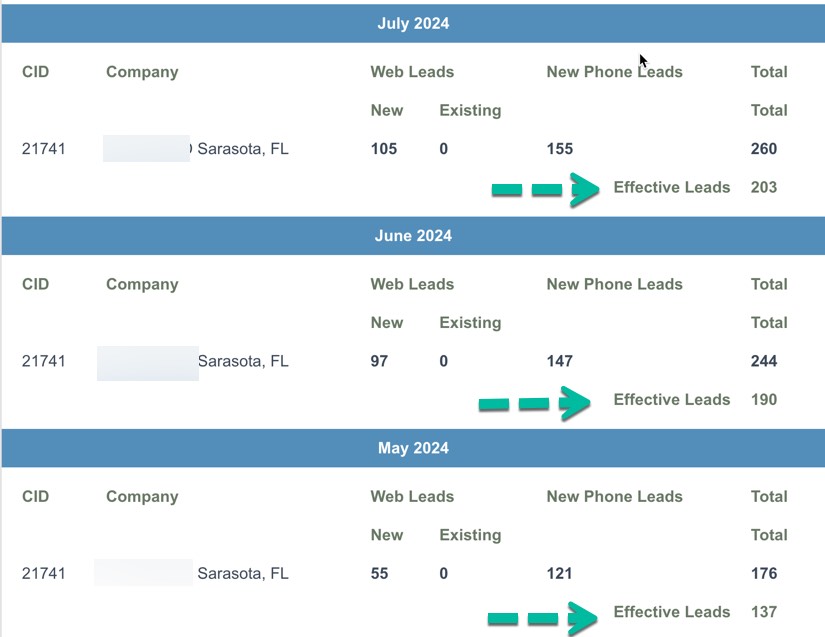
Example of medical SEO ROI of an Urgent Care
Urgent care located in California, in one of the most competitive areas of US. This urgent care is a single location, surrounded by 5 other urgent cares, including one owned by a local large hospital. There are 2 large chains located also. Using PLATINUM Service, for 5+ years, started with $4000/mon of Google ads. After 3.5 years, there are no ads, all new leads are coming from SEO and Local SEO optimizations, and the website conversion strategies. In the month of September 1483 new leads were recorded, and subtracting sales calls and duplicate appointments from existing patients, 1149 new leads are recorded. This practice has 8 exam rooms and sees 80 to 90 patients per day.
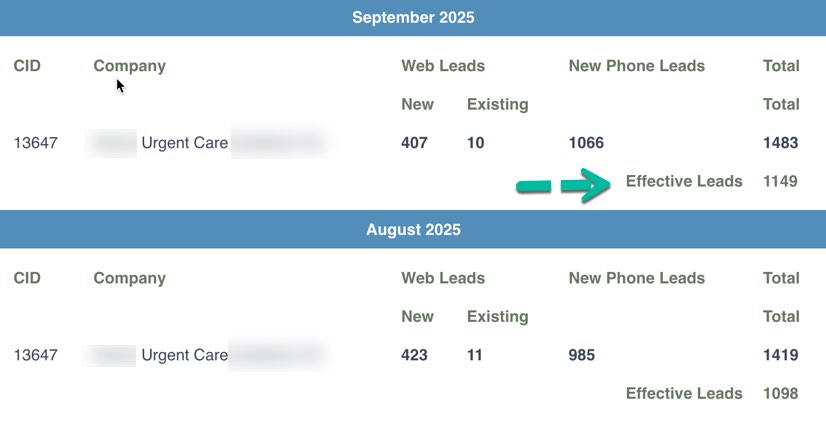
Contact us for an introduction Zoom meeting.
